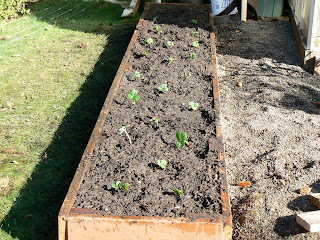Over the last several days Illijana and I have set about to construct a dedicated strawberry bed in our garden space. We needed a sunny spot and found one that fit near our greenhouse. We dug up the grass at the edge of the gravel pad we had put down for the greenhouse, dug up the weed mat that underlaid the gravel, moved some of the gravel, and laid out the bed shape.
 |
Cutting the edge
|
 |
| Laying out the bed shape |
The next step was to construct the raised beds using recycled deck boards given to us by our neighbors.
We laid out the boards, cut them to size, and used an Illijana inspired design nailing them together.
I then used a garden fork to loosen the soil at the base of the bed (like a double dig technique). In the background you can see some of the soil conditioners I used in the bed.
I amended the soils we gathered from around the yard with a mixture of blood meal, bonemeal, cottonseed meal, greensand, and lots of compost. The next photo is of our compost screener (a recycled plastic bread tray) as we loaded compost from the bottom of the pile to place in the new bed.
Finally, after many loads of soil, amendments, and compost were added, the bed was done. Here is what it looks like before the planting of the strawberry plants.



















































